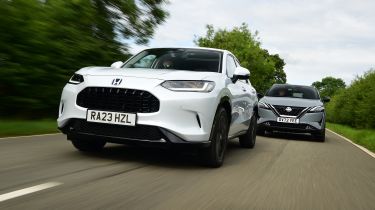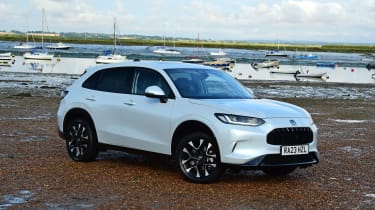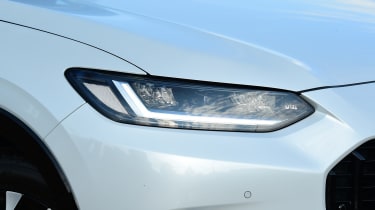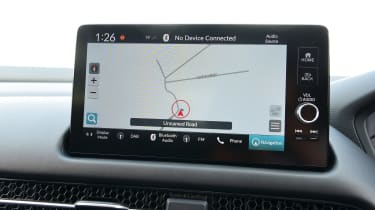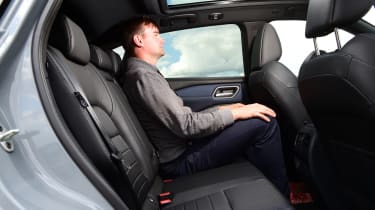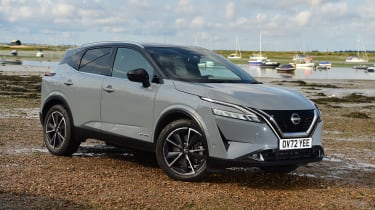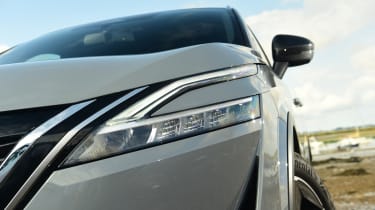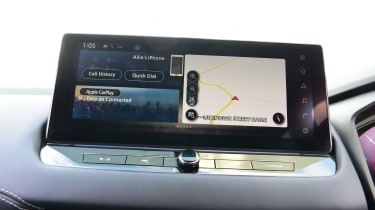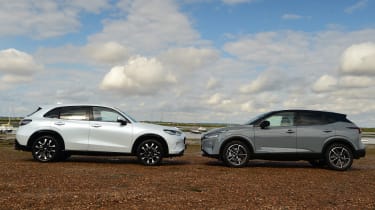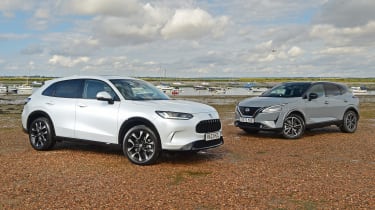Honda ZR-V vs Nissan Qashqai: 2023 twin test review
Honda is aiming at the big-selling Nissan Qashqai with its new ZR-V. We find out if it’s got what it takes
The family sports utility vehicle is such big business in Europe that many manufacturers feel the need for a couple of entries in the segment.
Honda, however, thinks that three is the magic number: this is the new ZR-V, and it joins the firm’s range with greater weight on its shoulders than its HR-V or CR-V rangemates, because it’s pitched directly against the Nissan Qashqai.
The car that kicked this class into overdrive 17 years ago is still going strong, with the Mk3 model currently third overall in the UK new-car sales charts for 2023. Can Honda steal some of its limelight?
| Honda ZR-V | Nissan Qashqai | |
| Price: | £42,895 | £42,050 |
| Powertrain: | 2.0-litre 4cyl HEV, 181bhp, front-wheel drive | 1.5-litre 3cyl turbo HEV, 188bhp, front-wheel drive |
| 0-62mph: | 7.9 seconds | 7.9 seconds |
| Test efficiency: | 45.6mpg/10.0mpl | 45.3mpg/10.0mpl |
| CO2: | 132g/km | 119g/km |
| Annual VED: | £170 | £170 |
Honda ZR-V
Honda has been on a roll recently, and the Civic is one of our favourite family hatchbacks. Can the ZR-V live up to the standards set by its little brother? Here we’re testing the SUV in top-spec Advance trim, which costs £42,895.
Tech highlights
Honda believes the lines between B-segment and C-segment SUVs are blurred to the point where the Japanese brand can shoehorn an extra sub-category between its existing HR-V and CR-V models. It’s a part of the class which contains the most popular family crossover of them all, the Nissan Qashqai, and one which Honda felt it needed to have a crack at. And it has started with a very promising mechanical base, because under the skin, the ZR-V is closely related to the brilliant new Civic.
Used - available now

2023 Land Rover
Range Rover Evoque
29,191 milesAutomaticDiesel2.0L
Cash £31,750
2020 Kia
Stonic
23,695 milesAutomaticPetrol1.0L
Cash £13,106
2021 Ford
Mustang Mach-E
24,663 milesAutomaticElectric
Cash £23,500
2020 BMW
1 Series
48,003 milesManualPetrol1.5L
Cash £15,897As with the Civic, the ZR-V is available in the UK exclusively as a hybrid. It’s a clever system, which allows the 2.0-litre four-cylinder engine to drive the front wheels directly at high speeds, or to disconnect completely from the front axle and send all of its energy to a 1.05kWh battery that powers an electric motor. Honda believes that this approach represents the best use of petrol and electric, using both power sources most efficiently.
Safety: While Euro NCAP hasn’t assessed the ZR-V yet, the Civic on which it is based chalked up a five-star rating. There are 11 airbags dotted throughout the cabin, including one that deploys between the driver and the front-seat passenger so that they don’t hit each other in the event of a side impact. The collision-warning and mitigation system uses a mixture of sonar detection and a camera, with a wide 100-degree viewing angle, in order to recognise objects and process whether to avoid them.
On the road
The ZR-V feels a lot more car-like to drive than many of its SUV rivals. While it isn’t particularly fun, it is relaxing and easy to use every day.
Around town: With drive coming directly from the electric motor at low speeds, the ZR-V feels just like a full EV – in other words, incredibly smooth, easy to control and far more responsive than an equivalent combustion-engined car. Precise steering makes the Honda easy to place, but the ride can be a little bit fidgety over smaller bumps.
A & B-roads: The ZR-V has been set up to be safe and predictable rather than fun, and it manages to hit that brief. Its slightly nose-heavy balance through the corners is matched with reasonable levels of grip, and a feeling of a low centre of gravity is reassuring on those occasions when you need to brake hard. The steering is not only precise but also really well weighted, which makes the Honda very easy – and actually quite satisfying – to place on the road.
Performance is strong, too, with the ZR-V feeling on the money for a claimed 7.9-second 0-62mph time. If the engine is already engaged, throttle response is keen, but when you ask for a large amount of power while cruising in electric mode, there’s a long pause as the petrol engine wakes up and then sends its drive to the front wheels. When it does, the four-cylinder engine is a little droney, but not overly loud.
Motorway: High-speed ride comfort is better than around town, and the ZR-V feels stable on long motorway runs. Road noise, particularly from the back axle, is a little more audible than we’d hope for. The lane-departure and blind-spot warning beeps are a little too excitable, too.
Ownership
In order to slot the ZR-V between its other two SUVs, Honda has been very precise when deciding its dimensions. At 4,568mm long, it’s 137mm shorter than the upcoming CR-V replacement, and 228mm longer than the HR-V. The SUV looks are slightly deceiving when you sit inside, because the seat is mounted just 30mm higher than in a Civic hatchback. The driving position is great, though, and the comfortable seat has lots of adjustment.
The dash design is also very like the Civic’s, which means there’s a clean, understated appearance with logical control layouts – including physical climate-control switches – and the build quality is excellent. A panoramic sunroof is standard on the Advance trim, and it lets lots of light into the cabin. An electrically retractable blind covers it up when necessary. Further back, the cabin has useful touches, such as a folding parcel shelf that is both sturdy and incredibly easy to remove and install.
Honda chalked up only a mid-table performance in the 2023 Driver Power survey, taking 18th place out of 31 brands in the manufacturers’ table. The Japanese maker doesn’t offer the most generous warranty package; while Korean competitors offer five and even seven-year warranties, the ZR-V gets a three-year, 90,000-mile deal.
Storage: The cabin storage is fairly hit or miss in the ZR-V, with the deep central storage bin falling into the former camp. The glovebox is quite large, too, and the wireless smartphone charging pad is a decent size. There’s also a small shelf beneath the floating section of the centre console, which houses two USB ports.
On the other hand, the door bins are small; the front ones are narrow and short, while the back pockets will only hold a small bottle. The robust optional rubber boot mat is ideal for carrying muddy clothing, and eliminates the chance of damaging the carpeted floor when loading a bike.
Practicality
Honda has focused on passenger space, and the ZR-V is very accommodating for its rear-seat occupants. The boot capacity, however, isn’t so impressive.
Rear Space: Rear legroom is fantastic, topping pretty much any other rival in this segment. The width across the cabin also has the beating of the Nissan. Headroom is fine, but not spectacular.
Boot: At 380 litres (including the underfloor storage), the boot isn’t just smaller than many rivals’, but also smaller than the Civic’s. That figure is 10 litres less than on other trim levels, because of the space taken up by the Bose subwoofer. You get an impressively low and level area, because the seat cushions slide down and forward as the seat backs are folded. Like this, the ZR-V’s space grows to 1,301 litres. There are two bag hooks (rated at 3kg each) and a 12-volt socket.
What to buy?
Which engine and trim we’d choose
- Engines: There’s just the single hybrid powertrain, but it delivers impressive fuel efficiency and lively performance.
- Trim: Even the base Elegance trim is generously equipped, but we’d go for Sport, which adds wireless smartphone charging, extra USB ports, a powered tailgate and half-leather seats. Top spec Advance adds a panoramic sunroof and a Bose sound system.
- Options: There isn’t much in the way of customisation for ZR-V buyers, with most personalisation coming from a range of colours and exterior styling packs.
- Our choice: The Sport offers the best balance between equipment and value.
Nissan Qashqai
The Qashqai in our pictures is in Tekna trim, priced at £39,210. To bring parity with the top-spec ZR-V Advance, our figures are based on the Nissan in its highest Tekna+ trim, costing £42,050.
Tech highlights
As with the Honda, the Nissan engages in a little platform sharing. In addition to using the same architecture as the larger Nissan X-Trail, the Qashqai also has one of its own rivals – the Renault Austral – sharing the same underpinnings, as part of the Renault-Nissan Alliance. However, both manufacturers have gone their own way with the development of the various models, especially when it comes to the powertrains used.
The Qashqai’s hybrid system operates on a similar principle to the Honda’s. The petrol engine – a 1.5-litre three-cylinder turbo unit with variable compression – never actually drives the front wheels directly. Instead, it behaves more like a generator. Its energy is sent to a compact 1.97kWh battery which, via a load of power electronics, drives a 188bhp electric motor.
Nissan says that this format allows the e-Power system to deliver the instant torque (a maximum of 330Nm is 15Nm more than in the Honda) and response you get from a fully electric vehicle, with the range of a petrol engine and the convenience of a quick refill at a service station.
Safety: Back in 2021, the Qashqai was awarded a five-star rating by Euro NCAP. Its individual scores were very impressive, too; marks of 91 per cent for Child Occupant protection and 95 per cent for the Safety Assist categories were the joint best recorded by any car that year. Nissan’s ProPilot assist system can keep the car centred in its lane, and it uses navigation data to anticipate bends and junctions, adjusting the car’s speed accordingly.
On the road
The Qashqai proves to be a little more comfortable and refined than the Honda, but the Nissan isn’t as composed.
Around town: Taking inspiration from the all-electric Ariya, the Qashqai has an e-pedal button. Unlike the Ariya, however, it doesn’t quite enable one-pedal driving; the deceleration is strong enough for everyday use, but instead of
the car coming to a full stop, it drops the speed down to a 5mph creep. Regardless of the brake-regeneration mode you choose, the Nissan is very easy to drive smoothly at low speeds.
A & B-roads: Irrespective of where you’re driving, the Nissan reveals a more forgiving ride quality than its rival. Although it’s not perfect – there are occasional jolts through the cabin – the Qashqai’s overall set-up is softer than the ZR-V’s, and there’s less fidget at low speed.
The flip side of the softer suspension is that it doesn’t feel quite so composed at higher speeds. While much of the Honda’s weight feels quite far forward, in the Nissan it seems more central, but higher up at the same time. This means that if you need to perform an emergency manoeuvre with the brakes or steering (or both), it isn’t quite as stable or as predictable at the limit of grip. The steering, which isn’t as precise as the Honda’s, also hampers the confidence it provides.
There’s very little to separate the pair in terms of acceleration. For the most part, the Qashqai is more than quick enough, and it matches the ZR-V’s claimed 0-62mph time to the tenth of a second.
Motorway: The Nissan remains comfortable and composed at higher speeds. Its engine is also less intrusive than the Honda’s when engaged.
Ownership
Nissan's interior design has taken a great step forward with its last two models. It’s at its best in the Ariya EV, but the Qashqai certainly feels like a big improvement over its predecessor, too. It all feels sturdy and substantial, thanks in part to a deep dashboard that sits the driver quite far away from the windscreen. The seating position has a more commanding SUV feel than the Honda’s, and the steering wheel is a little more angled downwards, which emphasises the high-riding feel.
Fit and finish are towards the top of the class, with blue leather-effect trim on the dash and doors adding a feeling of expense that the Honda can’t quite match. As with its rival, Nissan has found a decent balance between moving some functions onto a touchscreen while keeping others, such as the climate controls, still on physical buttons.
In our 2023 Driver Power customer satisfaction survey, Nissan finished an underwhelming 19th overall in the manufacturers’ category, one place behind Honda. Nissan owners gave their cars fairly middling scores across the board, with engine and gearboxes among their strongest suits.
Reliability wasn’t quite as impressive as for its rival here, with 19 per cent of owners experiencing at least one type of fault, compared with 15 per cent of Honda drivers. All new Qashqais come with a three-year unlimited-mileage warranty, backed up by three years of breakdown cover.
Storage: Deep and wide door bins are one area where the Nissan impresses for in-car storage. The glovebox is a reasonable size too, and the position of the large cup-holders in the centre console isn’t an issue, because they don’t get in the way of operating the Qashqai’s tiny gear selector.
Behind them sits a deep cubby beneath the central armrest, while the wireless smartphone charging pad is wide and has a rubberised surface to hold devices in place when on the move.
Practicality
The Nissan has more boot space than the Honda, but less room for rear-seat passengers. In either area, the Qashqai doesn’t really trouble the class leaders.
Rear space: Before you even step inside, there’s evidence that Nissan has given thought to young families, because the rear doors open to almost 90 degrees to make access as easy as possible. It’s especially useful when trying to fit a child seat, and the plastic covers over the Isofix brackets provide easier access than the Honda’s narrow slots in the upholstery. Adults will find slightly more headroom than in the ZR-V, but much less kneeroom.
Boot: The square and level boot makes stowing items fairly simple, although the load lip is 52mm higher than its rival’s. At 435 litres, the Qashqai has more volume than the Honda, and this grows to 1,379 litres with the back seats folded down.
What to buy?
Which engine and trim we’d choose
- Engines: In addition to the e-Power full hybrid, the Qashqai is also available with two mild-hybrid powertrains. The base model has 138bhp and is roughly £4,300 cheaper than the e-Power. The mid-range MHEV unit develops 156bhp and is available with four-wheel drive.
- Trim: Buyers can choose from Visia, Acenta Premium, N-Connecta, Tekna and Tekna+ trims. The mid-spec N-Connecta has all the kit most people will need.
- Options: Accessories aside, Tekna+ trim comes with almost every bit of kit Nissan can throw at it as standard.
- Our choice: We’d go for the e-Power powertrain in N-Connecta specification.
Results
Which car comes out on top?
Winner: Honda ZR-V
If we had to place an order for either of these cars today, then the Honda would just hold an edge. The ZR-V is more spacious inside than the Nissan, a little more fun to drive, and thanks to competitive finance incentives at the time of writing, it’s also slightly better value for money.
It also manages to maintain just enough of the Civic magic, and has clothed it in an SUV package that many buyers will find appealing. However, we can’t help but feel that if you look beyond the style, then the Civic is still a better car overall.
| Pros | Cons |
| Slick hybrid powertrain | Fidgety ride |
| Secure handling | Small boot |
| Generous equipment levels | Low driving position |
| Impressive rear-seat passenger space | Occasionally laggy powertrain |
Runner up: Nissan Qashqai
While the Honda wins this head to head as it stands, as soon as the ZR-V’s finance offers become less tempting, or the Qashqai’s deals become better, then the Nissan would have a clear opportunity to just nick this contest.
It remains a very capable hybrid family car, and if you prioritise boot volume over passenger space, and ride comfort over reassuring handling, plus can find a way to make the numbers work more in the Qashqai’s favour, the Nissan is still well worth considering.
| Pros | Cons |
| Comfort and refinement | Less surefooted than Honda |
| Large boot | Average rear legroom |
| Strong performance | ZR-V is more frugal, especially around town |
| Sturdy cabin |
Rivals and other options
The Honda ZR-V wins our twin test, but what else is out there?
- Same class: Hyundai Tucson Hybrid
- Same money: Toyota RAV4
- Used: Ford Kuga Hybrid
- Used: Skoda Enyaq iV
- Coming soon: Kia EV4
The great debate
What the Auto Express test team would do…
Sean Carson, associate editor: “The ZR-V sits well in its own class, yet we can’t help but feel most buyers would be better served by the Civic. It’s got the same hybrid powertrain, but is more comfortable, refined and fun to drive, and has a larger boot, too. Most importantly of all, it’s better value for money.”
John McIlroy, deputy editor: "Nissan has proven in recent years that it’s still capable of delivering box-office hits with the Ariya EV, but the Qashqai doesn’t quite live up to the incredibly high standards of its predecessor. Unfortunately for the Japanese brand, there are more talented alternatives out there now.”
Dawn Grant, picture editor: “I know styling is a subjective thing, but the Honda doesn’t look particularly exciting. In a class where the Hyundai Tucson, the Kia Sportage and even the Nissan Qashqai offer some dramatic design, I think that Honda could have tried to be at least a little bit more adventurous.”
Steve Fowler, editor-in-chief: “The outcome of this test proves just how important a strong finance offer can be, and how important it is to shop around for a deal. Honda has entered the class with some punchy deposit offers, and it is enough to make the ZR-V more appealingly priced than the Nissan.”
Dean Gibson, senior test editor: “While Honda has pipped its Japanese rival here, the next step up in the SUV class will see some daylight between the two brands. While the next CR-V is growing larger, Honda doesn’t have any plans to introduce a seven-seat version, something that the X-Trail does offer.”
Which would you buy? Let us know in the comments section below…
Specs and prices
| Honda ZR-V e:HEV Advance | Nissan Qashqai e-Power Tekna+ | |
| Petrol or diesel | Petrol | Petrol |
| MPG (WLTP) | 45.6 | 45.3 |
| Fuel price | 1.43 | 1.43 |
| P11D value | £35,255 | £38,705 |
| Fill up | 81.73 | 78.87 |
| On the road price/total as tested | £42,895/£43,690 | £42,050/£42,795 |
| Residual value (after 3yrs/36,000) | £21,876 (51%) | £20,201 (48.04%) |
| Depreciation | £21,019 | £21,849 |
| Annual tax liability std/higher rate | £2,185.91/£4,371.60 | £2,167.48/£4,335 |
| Annual fuel. cost (10k/20k miles) | £1,430 (£2,859) | £1,439 (£2,878) |
| Ins. group/quote/VED | 35/£597/£170 | 26/£582/£170 |
| Service costs (3 years) | £975 | £805 |
| Length/wheelbase | 4,568/2,657mm | 4,425/2,665mm |
| Height/width | 1,620/1,840mm | 1,625/1,835mm |
| Engine | 4cyl in HEV/1,993cc | 3cyl in HEV/1,497cc |
| Peak power | 181bhp | 188bhp |
| Peak torque | 315Nm | 330Nm |
| Transmission | eCVT auto/fwd | Single speed auto/fwd |
| Fuel tank capacity / spare wheel | 57 litres/repair kit | 55 litres/repair kit |
| Boot capacity (front / seats up/down) | 380/1,301 litres | 435/1,379 litres |
| Kerbweight/payload/towing weight | 1,639/516/750kg | 1,728/381/750kg |
| Turning circle | 11.3 metres | 11.1 metres |
| Basic warranty/recovery | 3yrs (90k)/3 yrs | 3 yrs (unlimited)/3 yrs |
| Driver Power manufacturer position | 18th | 19th |
| Euro NCAP: Adult/child/ped./assist/stars | N/A | 91/91/70/95/5 (2021) |
| 0-62mph/top speed | 7.9secs/108mph | 7.9secs/105mph |
| Test economy / range | 45.6/572 | 45.3/548 |
| WLTP combined | 48.7mpg | 53.3mpg |
| Number of airbags/Isofix points | 11/two | Six/two |
| Parking sensors/camera | F&r/yes | F&r/yes |
| Lane-keep assist/blindspot/AEB | Yes/yes/yes | Yes/yes/yes |
| Climate control/adaptive cruise | Two-zone/yes | Two-zone/yes |
| Leather/heated seats/wheel | Yes/yes/yes | Yes/yes/yes |
| Metallic paint/LED lights | £650/yes | £575/yes |
| Keyless entry & go/powered tailgate | Yes/yes | Yes/yes |
| Sat-nav/digital dashboard/USBs | Yes/yes/four | Yes/yes/four |
| Online services/wireless charging | Yes/yes | Yes/yes |
| Apple CarPlay/Android Auto | Yes/yes | Wireless/yes |

